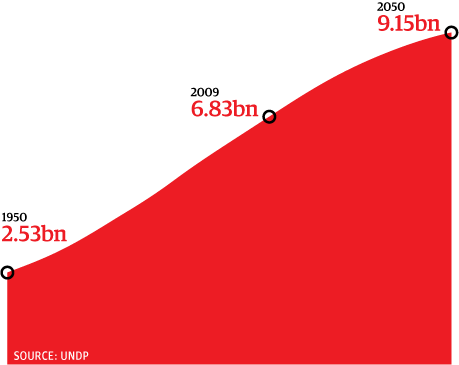India expected to become world’s largest country, passing China around 2028, while Nigeria could surpass the United States by 2050
New York, 13 June—The current world population of 7.2 billion is projected to increase by almost one billion people within the next twelve years, reaching 8.1 billion in 2025 and 9.6 billion in 2050, according to a new United Nations report, World Population Prospects: The 2012 Revision, launched today.
Most of the population growth will occur in developing regions, which are projected to increase from 5.9 billion in 2013 to 8.2 billion in 2050. During the same period, the population of developed regions will remain largely unchanged at around 1.3 billion people. Growth is expected to be most rapid in the 49 least developed countries, which are projected to double in size from around 900 million inhabitants in 2013 to 1.8 billion in 2050.
At the country level, much of the overall increase between now and 2050 is projected to take place in high-fertility countries, mainly in Africa, as well as countries with large populations such as India, Indonesia, Pakistan, the Philippines and the United States.
“Although population growth has slowed for the world as a whole, this report reminds us that some developing countries, especially in Africa, are still growing rapidly,” said Wu Hongbo, the UN Under-Secretary-General for Economic and Social Affairs.
Fertility higher than expected
Compared to the UN’s previous assessment of world population trends, the new projected total population is higher, particularly after 2075. Part of the reason is that current fertility levels have been adjusted upward in a number of countries as new information has become available. In 15 high-fertility countries of sub-Saharan Africa, the estimated average number of children per woman has been adjusted upwards by more than 5 per cent.
“In some cases, the actual level of fertility appears to have risen in recent years; in other cases, the previous estimate was too low,” said John Wilmoth, Director of the Population Division in the UN’s Department of Economic and Social Affairs.
In addition, slight modifications to the expected fertility trajectories of a few populous countries have led to higher projections of their future population size. Another contributing factor is a more rapid increase in life expectancy at birth anticipated for several countries: longer life, like higher fertility, generates larger populations. Advances in methodology have also contributed to changes in projected population trends.
Give or take a billion
Most results presented are based on the UN’s “medium-variant” projection, which assumes a substantial reduction in the fertility levels of intermediate- and high-fertility countries in the coming years. For these countries, it is assumed that the pace of future fertility decline will be similar to that observed for other countries, mostly in Asia and Latin America, when they underwent similar declines during the second half of the 20 century.
“The actual pace of fertility decline in many African countries could be faster or slower than suggested by this historical experience,” Mr. Wilmoth said. “Small differences in the trajectory of fertility over the next few decades could have major consequences for population size, structure and distribution in the long run.”
The “high-variant” projection, for example, which assumes an extra half of a child per woman (on average) than the medium variant, implies a world population of 10.9 billion in 2050. The “low-variant” projection, where women, on average, have half a child less than under the medium variant, would produce a population of 8.3 billion in 2050. Thus, a constant difference of only half a child above or below the medium variant would result in a global population of around 1.3 billion more or less in 2050 compared to the medium-variant forecast.
More and more large countries
The new projections include some notable findings at the country level. For example, the population of India is expected to surpass that of China around 2028, when both countries will have populations of around 1.45 billion. Thereafter, India’s population will continue to grow for several decades to around 1.6 billion and then decline slowly to 1.5 billion in 2100. The population of China, on the other hand, is expected to start decreasing after 2030, possibly reaching 1.1 billion in 2100.
Nigeria’s population is expected to surpass that of the United States before the middle of the century. By the end of the century, Nigeria could start to rival China as the second most populous country in the world. By 2100 there could be several other countries with populations over 200 million, namely Indonesia, the United Republic of Tanzania, Pakistan, the Democratic Republic of the Congo, Ethiopia, Uganda and Niger.
Large variations in fertility levels
Based on the information in the report, countries of the world can be classified into three groups depending on their current levels of fertility. In recent decades many countries have experienced major reductions in average family size.
It is now estimated that 48 per cent of the world’s population lives in “low-fertility” countries, where women have fewer than 2.1 children on average over their lifetimes. Low-fertility countries now include all of Europe except Iceland, plus 19 countries of Asia, 17 in the Americas, two in Africa and one in Oceania. The largest low-fertility(2) countries are China, the United States, Brazil, the Russian Federation, Japan and Viet Nam.
Another 43 per cent lives in “intermediate-fertility” countries, where women have on average between 2.1 and 5 children. Intermediate-fertility countries are found in many regions, with the largest being India, Indonesia, Pakistan, Bangladesh, Mexico and the Philippines.
The remaining 9 per cent of the world lives in “high-fertility” countries, where the average woman has 5 or more children. Of the 31 high-fertility countries, 29 are in Africa and two are in Asia (Afghanistan and Timor-Leste).
Africa growing rapidly
More than half of global population growth between now and 2050 is expected to occur in Africa. According to the UN’s medium-variant projection, the population of Africa could more than double by mid-century, increasing from 1.1 billion today to 2.4 billion in 2050, and potentially reaching 4.2 billion by 2100.
Rapid population increase in Africa is anticipated even if there is a substantial reduction of fertility levels in the near future. The medium-variant projection assumes that fertility will fall from 4.9 children per women in 2005-2010 to 3.1 in 2045-2050, reaching 2.1 by 2095-2100. The gap for Africa between the high and low variants of the new projections, corresponding to half a child more or less per woman compared to the medium variant, amounts to roughly 600 million people by 2050 (2.7 vs. 2.1 billion) and potentially 3.2 billion people by 2100 (6.0 vs. 2.8 billion).
Regardless of the uncertainty surrounding the future population of Africa, the region will play a central role in shaping the size and distribution of world population during this century.
Europe shrinking
Beyond Africa, the population of the rest of the world is expected to grow by just over 10 per cent between 2013 and 2100, with Europe’s population projected to decline by 14 per cent. Fertility in almost all European countries is now below the level required for full replacement of the population in the long run (around 2.1 children per woman on average). Fertility for Europe, as a whole, is projected to increase from 1.5 children per woman in 2005-2010 to 1.8 in 2045-2050, and to 1.9 by 2095-2100. Despite this increase, childbearing in low-fertility countries is expected to remain below the replacement level, leading to a likely contraction of total population size.
Longer lives around the world
Life expectancy is projected to increase in developed and developing countries in
Life expectancy is projected to increase in the world’s least developed countries (LDCs), which include many countries highly affected by HIV/AIDS. Life expectancy at birth in the LDCs was estimated to be 58 years in 2005-2010 but is expected to increase to about 70 years in 2045-2050, and 78 years by 2095-2100.
Low fertility drives population ageing
As fertility declines and life expectancy rises, the proportion of the population above a certain age rises. This phenomenon, known as population ageing, is occurring throughout the world.
Overall, the more developed regions have been leading this process, and their experience provides a point of comparison for the expected ageing of the populations of less developed regions. In 1950, the number of children (persons under age 15) in the more developed world was more than twice the number of older persons (those aged 60 years or over), with children accounting for 27 per cent of the total population and older persons for only 12 per cent. By 2013, the proportion of older persons in the more developed regions had surpassed that of children (23 versus 16 per cent), and in 2050, the proportion of older persons is expected to be about double that of children (32 versus 16 per cent).
Population ageing is less advanced in developing regions, especially in countries where fertility remains relatively high. In these regions, the proportion of children declined from 38 per cent in 1950 to 28 per cent in 2013, while the proportion of older persons increased from 6 to 9 per cent. However, a period of more rapid population ageing lies ahead for the less developed regions. By 2050, their proportion of older persons is projected to reach 19 per cent, whereas their proportion of children is projected to decline to 22 per cent.
For China and other areas, especially in East Asia, where fertility has been below the replacement level for several years, the report points out that population ageing is more advanced and is progressing more rapidly than in other parts of the developing world.
About the report
The report’s figures are based on a comprehensive review of available demographic data from around the world, including the 2010 round of population censuses. This information has been carefully compiled and systematically analyzed over the past two years by demographers working within the Population Division of the United Nations Department of Economic and Social Affairs.
------------------------------------------------------------------------------------------------
For the results of World Population Prospects: The 2012 Revision, visit www.unpopulation.org or contact the Office of the Director, Population Division, UN Department of Economic and Social Affairs, tel.: +1 (212) 963-3179, email: population@un.org. Send media inquiries to Mr. Wynne Boelt, UN Department of Public Information, tel.: +1 (212) 963-8264, email: boelt@un.org.







